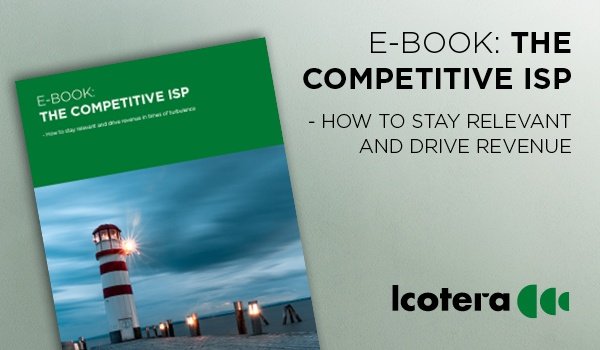In a market that is rapidly changing, the ISP's competitive edge is the key to success. With open network competition, changing customer behavior, the ISP’s business case is under pressure. Choosing the right business strategy and using customer data to deliver a proactive customer experience are two ways that will help ISPs build a strong business case.
European competition regulations have put an end to the practice of customers being locked into only using one internet service provider – which also installed the fiber connection. It is now a level playing field for ISPs, which is increasing competition and changing the ISP landscape, where network operators and ISPs have become independent entities.
At the same time, changing customer behavior is directly impacting the core of the ISP business. Regular TV – or flow TV – is declining, and landlines are nonexistent, reducing the ISP to a single-play - internet subscription - provider. Previously, customers purchased dual or triple-play services, which is a serious shift for the ISP’s business case:
– This behavioral change is disrupting the market composition as we know it. Nowadays, customers purchase their internet subscription with their ISP, while phone providers provide them with a mobile subscription, etc. This shift exposes the ISP to fierce competition, explains Erik Søe-Pedersen, Chief Commercial Officer at Icotera.
Ultimately, challenging the ISPs business case and adding pressure to choose the right go-to-market strategy.

"ISPs can find their differentiator in the knowledge of their customers and thereby offer more relevant and tailored solutions to their customers. Differentiating their product portfolio will enable ISPs to deliver a stronger customer experience, which in turn drives customer loyalty” Erik Søe-Pedersen, Chief Commercial Officer, Icotera
Choosing the right strategy
With the increased business opportunities on the open networks, new ISPs are emerging in the market. Compared to large legacy ISPs, they run their business with a classic disruption strategy. Søe-Pedersen states that there are two overall strategic paths ISPs can take: Either become cost-driven or differentiate.
– New ISPs have not incurred the historical costs involved when rolling out fiber, so their startup costs are minimal from the outset. They are often smaller businesses, inherently digital, and operate a cost-driven strategy with ‘one-size-fits-all’ products. By default, they have a better business case and are more cost-competitive, says Søe-Pedersen.
Whereas newcomers often operate with a cost-driven strategy, legacy ISPs still have an ace up their sleeve: They have an existing customer base and customer relationships to draw from. The newcomers do not.
He points out that larger ISPs often have a higher cost base due to their organizational size and operational expenses, including complex systems and long-tenured employees. Therefore, Søe-Pedersen points to legacy ISPs’ differentiation as a solution to the problem:
– ISPs can find their differentiator in the knowledge of their customers and thereby offer more relevant and tailored solutions to their customers. Differentiating their product portfolio will enable ISPs to deliver an extraordinary customer experience, driving customer loyalty.
Using customer data to drive customer loyalty
Utilizing customer data to identify new customer needs will help ISPs build the ultimate business case, where their offerings are indispensable, and customers are increasingly loyal. According to Søe-Pedersen, this is achievable for most ISPs:
– Simply put: It requires a strong core product where you deliver an internet connection that is powerful in all corners of the home. And to meet changing customer behavior, a powerful and robust Wi-Fi solution is even more relevant.
Including other products in the core offering which are highly relevant, convenient, and are seamlessly incorporated into the core offering, we expect these to increase over the coming years — for example, in-home alarm systems connected via Wi-Fi routers.
But being proactive will be key in driving customer loyalty. ISPs could more proactively solve specific customer problems that prevent them from harnessing the full potential of their service, explains Søe-Pedersen:
– Using your customer data and proactively delivering extra services to improve customers’ experience does not demand much of ISPs. It is an effective way of providing an exceptional experience. A customer interaction could instead play out like this: “I can see that you have X problems, do you sometimes experience this? Shall we look at this for you?”
He concludes: – It costs a lot of time and money to acquire a customer but not as much to retain them. Investing in the right resources will enable ISPs to maintain their competitive edge.
FAST TRACK:
- Changes in competition regulations and customer behavior have resulted in dual and triple-play services no longer being desirable for customers. Internet service providers have been reduced to a single-play service and particularly exposed to competition.
- ISPs can choose to apply a cost-driven strategy or differentiate their entire product portfolio. Newcomers often use a cost-driven approach, where the product is ‘one-size-fits-all’. Legacy ISPs can more easily differentiate and deliver exceptional service.
- Using customer data to drive customer loyalty will help ISPs make their offerings indispensable to customers. By providing proactive customer experiences, customers will harness the full potential of their internet service.
![]()
WANT TO KNOW MORE about how your ISP business can stay ahead of the competition and achieve long-term competitive resilience, enabling you to run your business in ever-changing market conditions? Download our E-book: The competitive ISP - Enjoy the read!
Download E-book: The competitive ISP here

